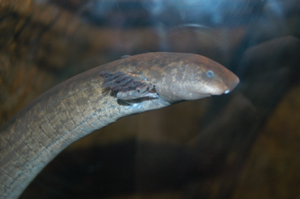Category:
AmphibiansAbout
Greater Siren
The greater siren (Siren lacertina) is another fully aquatic salamander much like the mudpuppy salamander. It has external gills, as well as lungs which are used for drawing oxygen from the water and air respectively. Unlike the mudpuppy, sirens only have one pair of spindly legs located behind their gills. Sirens are a much larger species of salamander obtaining a length of 20 to 40 inches, and up to 4 inches in diameter. These fascinating amphibians are a dusty gray, with the ventral surface being more of a blue-gray mottled with yellow spotting.
Sirens are found the coastal plain region of Virginia inhabiting densely planted ponds, lakes, streams and rivers. These nocturnal animals tend to forage at night where they search out some of their favorite food items including worms, aquatic insects, fish, and mollusks. During drought or scarce food, sirens may survive only on their extensive fat deposits for over a year.
Sirens are known to mate in late winter or early spring. Females attach up to 500 eggs individually to submerged vegetation. The baby sirens are less than one inch long after hatching from the egg. Unlike the adults, young sirens have a yellow or red stripe running down each side of their body that will fade with age.
These amphibians are not currently protected, but populations are threatened by habitat loss, draining of wetlands, and pollution.
Greater Siren information from the Virginia Department of Game and Inland Fisheries






